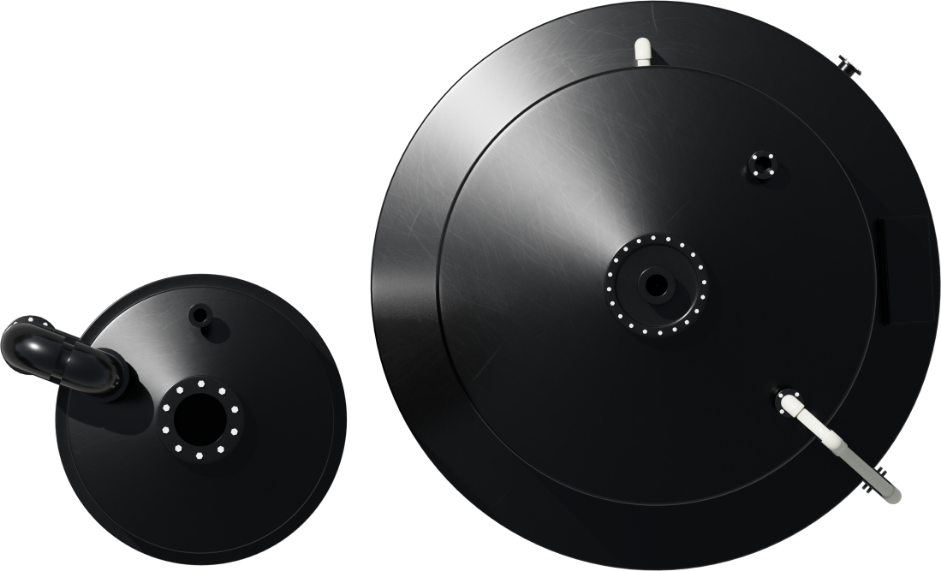Experience the convenience of automation with the NIPLAST® SALTURATOR®️’s largely automated saturation process. Various levels of water, salt, and brine assessment are available, allowing for optimal customisation and control. Thanks to NIPLAST®’s bespoke manufacturing processes, there are no diameter restrictions, making it easy to overcome on-site or access difficulties. The SALTURATOR® tanks are available in different storage and recharge capacities, allowing for efficient utilisation of available space and cost-effective salt delivery modes.
Elevate your on-site brine production with NIPLAST® SALTURATOR®️, the industry-leading solution that combines reliability, efficiency, and flexibility. Trust in NIPLAST®’s expertise to revolutionise your salt saturating process.
On site brine production is an essential requirement in many processing industries, including food production, water treatment, pharmaceutical and chemical manufacture.
The NIPLAST® range of SALTURATOR® salt saturators is designed for just such on site applications, to accept road tanker or IBC deliveries of salt, to control the incoming water flow, to filter and to then deliver the subsequently produced brine solution.
The salt saturating process occurs in the NIPLAST® system, housed within a NIPLAST® tank body manufactured from corrosion resistant UV stabilised polypropylene.
The primary features of a NIPLAST® system include an aluminium salt delivery line for pressurised road tanker delivery, a water inlet system controlled via ball float valve or other control system, low-level side entry access with viewing window for easy salt level assessment, a 2-layer gravel filter bed, floor mounted brine collection pipe, powder vent or powder collection system.
Salt is delivered via the delivery line and is directed to sit on the top of the 2-layer gravel bed. Water is introduced and percolates through the salt, with the water dissolving the salt layer as it passes through.
Saturated brine solution contains circa 26.5% salt by weight and has a specific gravity of 1.20. The amount of brine the NIPLAST® SALTURATOR® can produce is directly proportional to its capacity.
The saturation process within the NIPLAST SALTURATOR® is largely automated and different levels of water, salt and brine assessment are available.
NIPLAST®’s bespoke manufacturing processes mean there are no diameter restrictions, so on site or access difficulties can be overcome. NIPLAST® SALTURATOR® salt saturator vessels are available in different storage and re-charge capacities to suit available space on site and the most economically efficient salt delivery modes..
Niplast has been known for its unmatched quality for over 40 years. Our products are known for their exceptional performance, with innovative features.
Our PP or HDPE construction to BS EN 12573, long-lasting brine resistance, advanced safety options, and salt level visibility demonstrate our commitment to delivering superior products that exceed expectations. Trust Niplast to elevate your salt saturating process with our unrivaled expertise and industry-leading solutions.
A key feature that you’ll want to look out for in your salt saturator is brine resistance. Our salt saturators are made from non-corrodible elements such as PP or HDPE to make sure that they are built with longevity in mind.
Salt saturators are used in multiple industries such as water treatment, food and chemical manufacturing where brine solutions are relied upon. The more resistant to brine, the fewer maintenance costs will be needed over time.
Salt saturators are essential devices used in various industries to produce and manage brine solutions efficiently. Understanding how salt saturators work is crucial for their proper operation and maintenance. Here’s an overview of the fundamental principles behind their functioning:
Salt saturators are primarily employed to produce brine solutions, which are essentially water saturated with salt or bed of salt (usually sodium chloride). The process begins by adding a predetermined quantity of salt to the saturator’s tank or chamber.
Once the salt has been added to the saturator, water is then introduced into the tank and the salt can begin to dissolve. The process of salt dissolving in water happens naturally as water acts as a solvent so the water dissolves the salt. The dissolving process is dependent on factors such as temperature and agitation.
As more salt is added to the water and it continues to dissolve, the solution reaches a point of saturation. At this stage, the water can no longer dissolve additional salt (or pdv salt), and any excess salt will remain undissolved at the bottom of the saturator tank.
To maintain a consistent brine concentration, salt saturators often feature sensors or monitoring systems that continuously measure the concentration of the brine. These sensors provide feedback to control systems that can adjust the salt feed rate to ensure the desired concentration is maintained.
Once the brine solution reaches the desired concentration, it is ready for storage or immediate use, depending on the industry’s requirements. In applications like water treatment or food processing, the brine may be stored in dedicated tanks for future use or directed to the specific process where it is needed.
With over 40 years of brand heritage, Niplast are experts in manufacturing plastic bulk storage tanks to strict CEN standard BS EN 12573 and its forerunner DVS 2205.
Our long history of applying these standards innovatively to solve chemical storage problems our clients meet, is what sets us apart. Sometimes you need to think outside of the tank
Today, with over 40 years of brand heritage, Niplast is an expert in manufacturing plastic bulk storage tanks or industrial tanks to strict CEN standard BS EN 12573 and its forerunner DVS 2205.
Our long history of innovatively applying these standards to solve chemical storage problems sets us apart from other brands of underground water tanks and chemical storage solutions. Sometimes, you need to think outside of the tank!
Contact Us